Alcoa Road, Dominican Republic
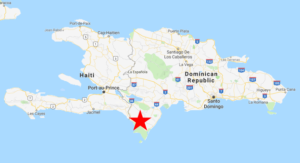
Alcoa Road is unique in the D.R., a quiet, paved, easily drivable road through prime mountain forest habitat. As its name suggests, it owes its existence to a bauxite mine, long abandoned. But now and for the foreseeable future, it leads only to Sierra de Bahoruco National Park. Also known as El Aceitillar, Alcoa Road offers good prospects of finding localized endemics such as Hispaniolan Nightjar, Hispaniolan Parrot, Hispaniolan Palm Crow, Golden Swallow, Hispaniolan Crossbill, and Antillean Siskin, among others.
Orientation
Directions
The low end of Alcoa Road passes underneath Route 44 approximately 10 km east of Pedernales at an unusual junction with unpaved spurs that link the two paved roads. The 110 km from Barahona to this junction usually takes foreign drivers about two hours, as Route 44 has many slow sections—first winding south along the coast and passing through several small towns until turning inland (west) at Oviedo, then becoming straight and empty but riddled with potholes. Local drivers who know the road well can make the trip in under an hour and a half.
Although the junction is a lone anomaly on a deserted, uniform stretch of Route 44, it is surprisingly easy to miss, especially when approaching from Pedernales, and especially in the dark. Route 44 passes directly over Alcoa Road without a noticeable change in elevation or scenery. Watch for road signs that indicate either Cabo Rojo, Hoyo del Pelempito, or Sierra de Bahoruco National Park.
The off-ramps from Route 44 to Alcoa Road are dusty tracks about 100 m and 200 m west of the overpass. After taking either off-ramp, upon reaching pavement again, turn left toward the park and Hoyo del Pelempito (a right turn would take you to Playa Cabo Rojo). For the first 18 km, the road traverses dry, hot scrub and pastureland, before it winds up into the forest where most of the birds are.
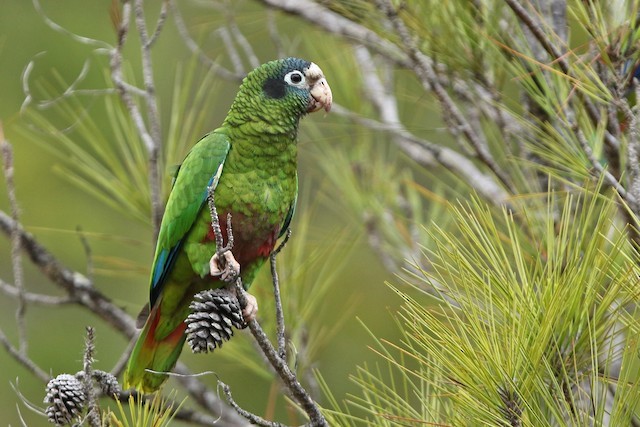
Hispaniolan Parrot beside Alcoa Road. © Volker Hesse
Attractions
Bahía de las Águilas. Most tourists who visit this remote corner of the D.R. come to experience the famously beautiful beach and turquoise waters of Bahía de las Águilas, which is reached by taking Alcoa Road south from Route 44. From either off-ramp described above, turn right and drive 6 km of paved road to the Cabo Rojo airport, then continue a further 6 km on a reasonable dirt road to the tiny fishing village of Las Cuevas on the boundary of Jaragua National Park.
The road into the park is too rough for all but the most rugged high-clearance four-wheel-drive vehicles. Visitors without such a vehicle can walk the steep 2 km track overland to reach the beach, but most prefer to go by boat around the dramatic rocky headland that separates Las Cuevas from Bahía de las Águilas. Local fishermen offer rides for about U.S.$60 per trip—about $10 per person if the boat is full.
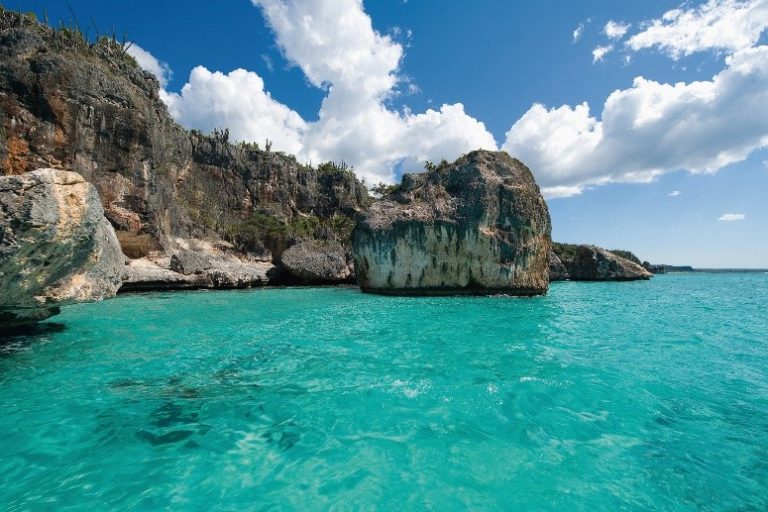
This rocky headland separates Las Cuevas from Bahía de las Águilas. © Go Dominican Republic
Birdfinding
The best way to explore Alcoa Road begins with a predawn drive, preferably a short one from Pedernales starting two hours or more before dawn to allow time to search for night birds along the way.
Night Birds. “Caribbean Potoo” and Least Pauraque have been reported in the scrub around 6 to 7 km from Route 44, but they might not occur regularly. Hispaniolan Nightjar is numerous in the mixed forest between 18 and 22 km from the junction—especially around the one true hairpin turn, which is the most reliable place to find this species. Several males can often be heard calling in this area, and the layout of the road facilitates searching for them. Ashy-faced Owl also inhabits the mixed forest zone, and Stygian Owl occurs sparingly in the pine forest above.
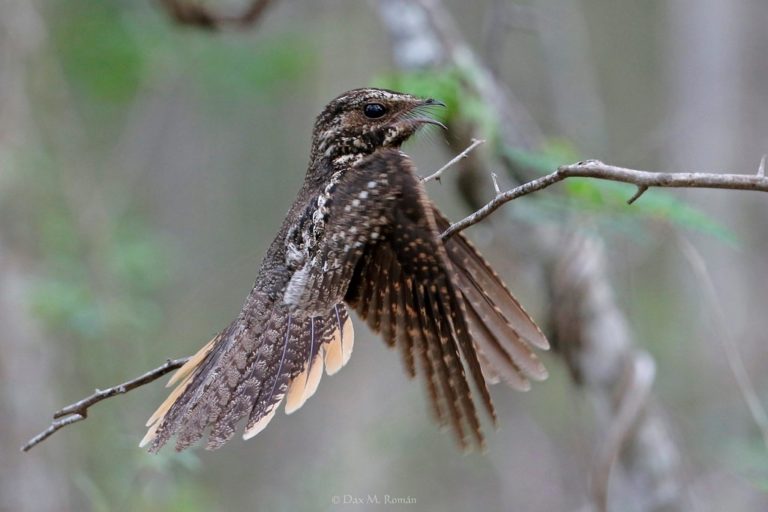
The mixed forest zone of Alcoa Road is the best place to search for Hispaniolan Nightjar. © Dax M. Román E.
Mixed Forest Zone. Between 18 and 22 km from the junction, the road climbs through a moist mixed pine and broadleaf forest that is usually the most productive part of the road, and the best place to be at dawn. Interesting birds that are often observed in this stretch include: “Hispaniolan Sharp-shinned Hawk”, Plain Pigeon, Hispaniolan Emerald, Narrow-billed Tody, Hispaniolan Parrot, Hispaniolan Parakeet, Hispaniolan Pewee, Hispaniolan Euphonia, and Green-tailed Warbler. The long straight segments immediately above and below the hairpin turn are especially productive in part because they afford the best views into the forest.
El Charco. Around 22 km the road plateaus and the forest becomes pine-only. Shortly after this transition a conspicuous pull-off on the right leads to “El Charco,” a concrete water-retention pit that is somewhat of an oasis in the dry pine forest, and has often produced Golden Swallow and Hispaniolan Crossbill, among many others.
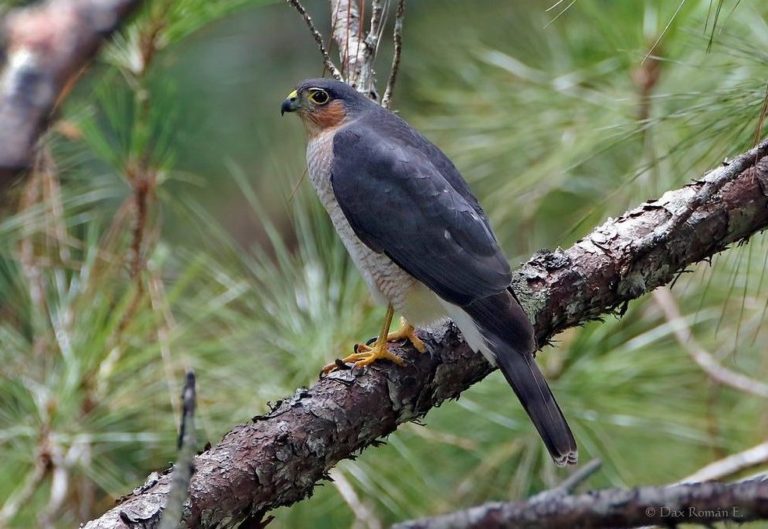
“Hispaniolan Sharp-shinned Hawk” is classified as a subspecies, but a good candidate for recognition as a full species. © Dax M. Román E.
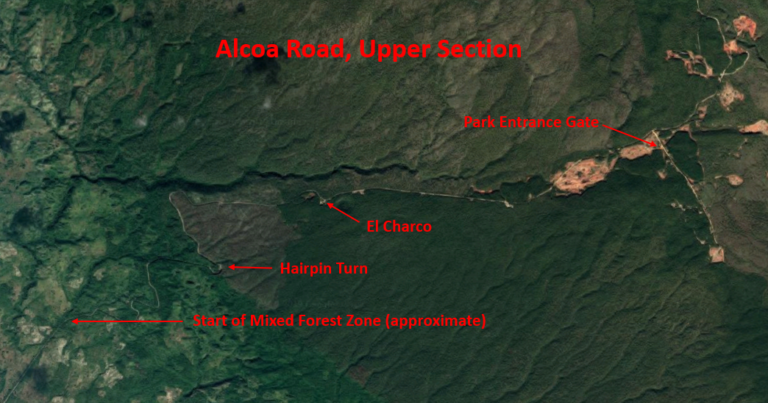
The main areas of interest along Alcoa Road are between the start of the mixed forest zone and the park entrance gate.
Pine Forest Zone. Beyond El Charco the road proceeds straight through another 3 km of unbroken pine forest, then continues unpaved beside strip-mined pits for 2 km, reaching a perpendicular junction. Both roads are gated entrances to the Sierra de Bahoruco National Park. The left fork (straight ahead) is closed to all but official vehicles, but it is an excellent trail, Sendero de Bahoruco (the Bahoruco Trail), for a quiet walk through the pine forest. The right fork is the road to Hoyo del Pelempito, with a manned gate that opens to the public daily from 8:00 to 17:00.
The general vicinity of the park entrance gate and Bahoruco Trail are good for the key Alcoa Road pine-associated target species, such as Hispaniolan Parrot, Hispaniolan Elaenia, Hispaniolan Palm Crow, Golden Swallow, Pine Warbler, Hispaniolan Crossbill, and Antillean Siskin. Beside the guard shack is a water dish where the crossbill and siskin are nearly guaranteed—the most reliable place for finding find both of these endemics.
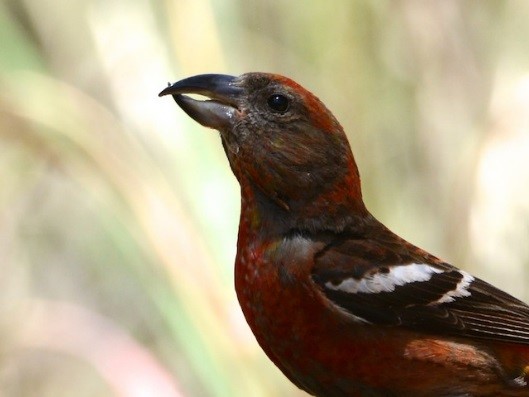
Male Hispaniolan Crossbill drinking from the water dish at the park entrance gate on Alcoa Road. © Alan Van Norman
Hispaniolan Palm Crow is fairly common throughout the pine forest zone of Alcoa Road, but not at any particular site within it. Visitors who are intent on finding this species should try to cover a lot of distance, stopping frequently to listen for the crows.
Hoyo del Pelempito. 10 km past the park entrance, approximately 40 km from Route 44, Alcoa Road finally dead-ends at the edge of Hoyo del Pelempito, a spectacular, steep-walled, crater-like depression. There is a small visitor center and a trail that leads down into the basin’s moist deciduous forest. It seems that few birdwatchers have explored Hoyo del Pelempito, likely due to its remoteness and daily time restrictions on access.
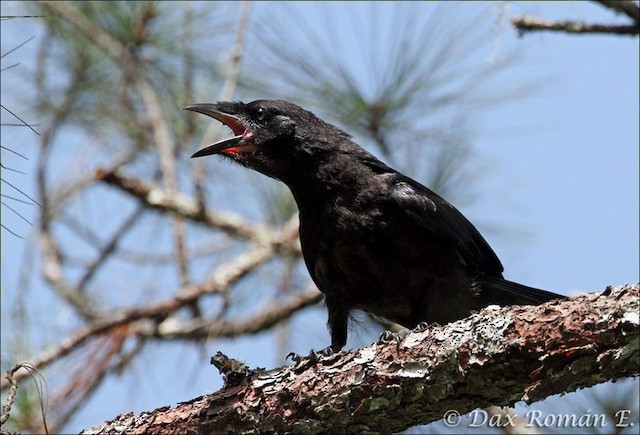
Hispaniolan Palm Crow beside Alcoa Road. © Dax M. Román E.
Services
Accommodations
The nearest town to Alcoa Road, Pedernales, is a dusty, unappealing border town with many hotels. Two mid-range hotels in the immediate downtown area that have a history of serving foreign visitors are:
Hostal Doña Chava, Calle 2da 5, 809-524-0332
Hostal D’Ólio Méndez, Calle Antonio Duvergé 9, 809-524-0416
They are nearly adjacent to one another one block north of the main street, Avenida Libertad, shortly after entering the downtown area from the east—about 1 km past the bank with the town’s only ATM, BanReservas. Both are in the range of U.S.$20-$30 per night.
Two blocks farther north, on Calle 16 de Agosto, are the pricier Hotel Vista de las Águilas and Hotel Alba Coral.
One block farther north, an attractive budget option is the Hostal B&B Italia Caribe.
Another four blocks farther north, at the intersection of Calle Santo Domingo and Calle 1ro de Abril, the Hotel Pedernales Italia is another mid-range option that has received favorable reviews.
On the south side of Avenida Libertad, a left turn down Calle Caracol past the baseball fields leads to a series of six budget or mid-range hotels: Hotel Caracol, Hotel Don Muelle, Hospedaje Valenzuela, Casa Bahía de las Águilas, Hotel Costa Marina, and Hotel Villas del Mar.
There are, in addition, many hotels in Pedernales not mentioned here. Most organized tours traditionally launch their explorations of Alcoa Road from the far more distant town of Barahona, but independent travelers should be aware that Pedernales, though less attractive, is more convenient.
Food
Alcoa Road has no businesses of any kind, so visitors must obtain food and water elsewhere. Pedernales is replete with corner grocery stores and restaurants.
By many accounts, the most convenient good restaurant in town is Restaurante Jalicar, located on Avenida Libertad 1 km west of BanReservas.
The most popular seafood restaurant in Pedernales is the King Crab Café, which is three blocks south of Avenida Libertad on the main north-south street, Calle Fernando Dominguez.
For Italian food, two popular options are the Hotel Pedernales Italia or the Restaurante Italiano Barbara y Daniele, on Calle Santo Domingo between Calle 27 de Febrero and Calle 16 de Agosto.
For breakfast, the recommended bakery is Panadería Victoria in the heart of downtown on Avenida Libertad.
The best-stocked grocery store is Supermercado Pedernales, on Calle Fernando Dominguez two blocks north of Avenida Libertad.
Notes
When to Visit
Time of year is somewhat less important here than at other forested sites in the D.R., but it is better in the breeding season, February through May, when the endemics are most vocal and conspicuous.
Hazards & Hassles
Alcoa Road is a largely deserted area near a border town, which presents inherent risks of smugglers and opportunistic crime. Residents of Pedernales have warned some visitors to avoid the road at night due to stories of highway bandits robbing tourists. Such warnings are likely overblown, but the setting does invite potential lawlessness, so the normal precautions of urban birdwatching are advisable: remain alert to your surroundings, stay close to your vehicle, and be wary of other people’s intentions, especially late in the day. Fortunately, Alcoa Road is best sampled by driving slowly and pulling over frequently to stroll, and traffic is almost nonexistent, so these basic precautions do not impede enjoyment of the site.